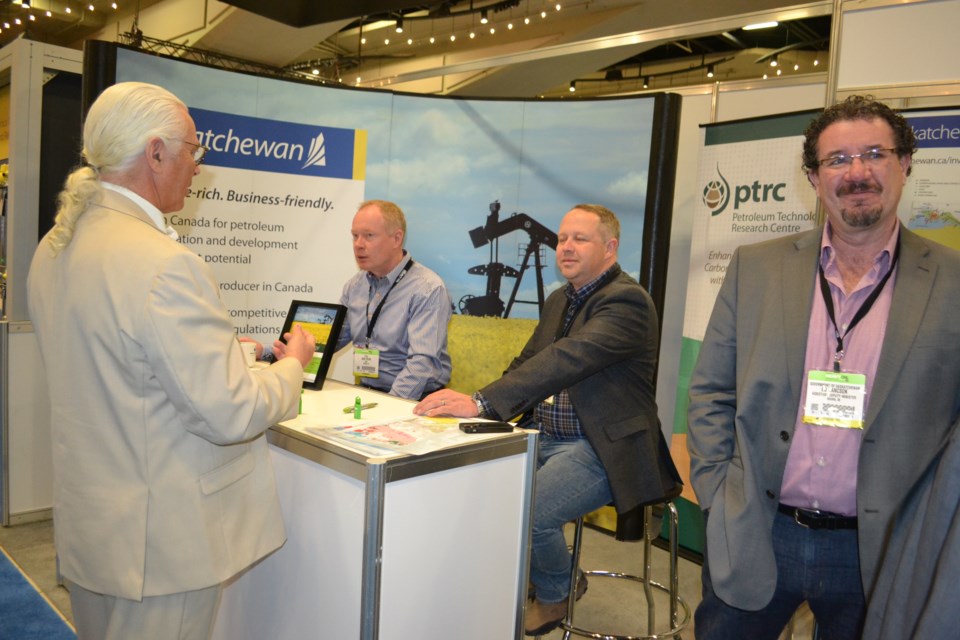Edmonton–Come to Saskatchewan to invest in thermal processes and enhanced oil recovery (EOR) and emerging technologies.
That was one of the messages that industry officials from Regina and Saskatoon were making to some of the 1,000 global delegates at the World Heavy Oil Congress held in Edmonton March 24-26.
“We always come to the heavy oil congress to try to raise the profile of Saskatchewan’s oil and gas resources – in this particular case – the heavy oil resources of Saskatchewan,” said Ed Dancsok, assistant deputy minister with the Petroleum and Natural Gas Division in Regina.
Danscok teamed up with representatives from Saskatchewan’s Petroleum Technology Research Centre (PTRC) during the exhibition portion of the heavy oil congress held at the Shaw Convention Centre.
“We are next to Alberta, a big heavy oil producer, but we want to make sure we’re noticed and we can attract investments for our resources as well as investment into our technology,” explained Dancsok.
The Saskatchewan Research Council (SRC) was also on hand promoting its heavy oil and gas research and development projects focused on EOR.
Steam-assisted gravity drainage, or SAGD, commonly used to produce heavy oil in the Lloydminster and Kerrobert areas, fits Saskatchewan’s plans for economic growth according to Dancsok.
“We are looking to use innovation and technology to carry on with better recovery of our oil resources, increase production and continue the growth of Saskatchewan,” he said.
“It’s not only finding new oil with old ideas; it’s finding old oil with new ideas and that is technology.
“We have folks from the PTRC right here. They’ve seen a lot of traffic during the show – a lot of people talking about new ideas.”
Some of the emerging technologies discussed during the technical conference ranged from electromagnetic heating of heavy oil reservoirs to combining solvent injection, electromagnetic heating and hydraulic fracking for multi-stage oil recovery in horizontal wells.
SRC is also researching microbial and enhanced waterflooding for heavy oil EOR.
“It’s not only steam anymore; it’s using carbon dioxide; it’s using solvents or any sort, polymers and combinations of all of them, and finding out what’s the best recipe and the best recovery,” said Dancsok.
“We are seeing really good results out of our SAGD with some areas recovering close to 60 per cent of the oil in place.”
Despite the current low oil price environment, Dancsok is stoked over the potential for continued growth of heavy oil production in the province.
“Our major heavy oil producer, Husky, still has plans to carry on with the projects that they have approved. They are either in mid-construction or about to start construction,” he said.
Construction is under way at Husky’s 10,000 barrels per day Rush Lake heavy oil thermal project with first oil scheduled for the third quarter of 2015.
Work is also proceeding at the 10,000 bpd thermal projects at Edam East and Vawn, with first oil planned in the third and fourth quarter of 2016.
The 3,500 bpd Edam West thermal development remains on track for start-up in the fourth quarter of 2016.
“Those are in order of $100 million projects,” said Dancsok.
“We have a couple of other projects approved for Northern Blizzard. They’re in the $100 million range as well. They are planning to carry on with those. Those are thermal projects.”
In 2015, Northern Blizzard plans to commence Phase 3 of its Kerrobert Bakken polymer flood expansion, at Cactus Lake, west of Luseland with completion expected in early 2016.
Phase 3 is expected to add 69 producers and 29 injectors.
The low viscosity oil in the Mississippian Bakken formation responds well to infill drilling and waterflooding.
The company is currently expanding its SAGD project at Plover Lake, east of Kerrobert to bring an additional horizontal well pair on stream.
First oil from this expansion is expected during the second quarter of 2015.
Serafina Energy Ltd., a private equity funded thermal developer and producer is in the process of building their first 6,000 bpd SAGD project in Edam.
“There are probably five projects worth $100 million of investment each, and all of them are planning to carry on with them,” said Danscok despite the downturn.
“So that’s pretty good news.”
He also said the theme of the 2014 heavy oil congress, Producing More with Less, “fits Saskatchewan to a tee” when it comes to research and development of EOR technologies.
“It’s a very good example of what we do in pragmatic and innovative ways to get the oil and gas that Saskatchewan has out of the ground,” explained Dancsok.
“Saskatchewan has set another production record in 2014. We are producing over 500,000 barrels a day now, which is triple what we were producing 30 years ago.
“We are continuing that growth. We just inched past Alaska into fifth place in all of North America for all oil.”




